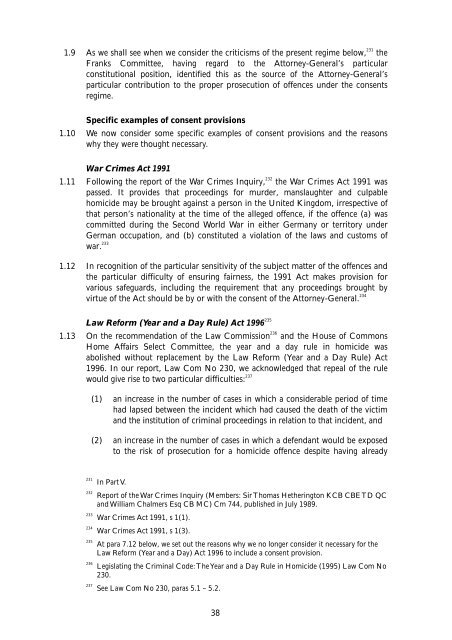cp149 Consents to Prosecution consultation - Law Commission
cp149 Consents to Prosecution consultation - Law Commission
cp149 Consents to Prosecution consultation - Law Commission
Create successful ePaper yourself
Turn your PDF publications into a flip-book with our unique Google optimized e-Paper software.
1.9 As we shall see when we consider the criticisms of the present regime below, 231<br />
the<br />
Franks Committee, having regard <strong>to</strong> the At<strong>to</strong>rney-General’s particular<br />
constitutional position, identified this as the source of the At<strong>to</strong>rney-General’s<br />
particular contribution <strong>to</strong> the proper prosecution of offences under the consents<br />
regime.<br />
Specific examples of consent provisions<br />
1.10 We now consider some specific examples of consent provisions and the reasons<br />
why they were thought necessary.<br />
War Crimes Act 1991<br />
1.11 Following the report of the War Crimes Inquiry, 232<br />
the War Crimes Act 1991 was<br />
passed. It provides that proceedings for murder, manslaughter and culpable<br />
homicide may be brought against a person in the United Kingdom, irrespective of<br />
that person’s nationality at the time of the alleged offence, if the offence (a) was<br />
committed during the Second World War in either Germany or terri<strong>to</strong>ry under<br />
German occupation, and (b) constituted a violation of the laws and cus<strong>to</strong>ms of<br />
war. 233<br />
1.12 In recognition of the particular sensitivity of the subject matter of the offences and<br />
the particular difficulty of ensuring fairness, the 1991 Act makes provision for<br />
various safeguards, including the requirement that any proceedings brought by<br />
virtue of the Act should be by or with the consent of the At<strong>to</strong>rney-General. 234<br />
<strong>Law</strong> Reform (Year and a Day Rule) Act 1996 235<br />
1.13 On the recommendation of the <strong>Law</strong> <strong>Commission</strong> 236<br />
and the House of Commons<br />
Home Affairs Select Committee, the year and a day rule in homicide was<br />
abolished without replacement by the <strong>Law</strong> Reform (Year and a Day Rule) Act<br />
1996. In our report, <strong>Law</strong> Com No 230, we acknowledged that repeal of the rule<br />
would give rise <strong>to</strong> two particular difficulties: 237<br />
(1) an increase in the number of cases in which a considerable period of time<br />
had lapsed between the incident which had caused the death of the victim<br />
and the institution of criminal proceedings in relation <strong>to</strong> that incident, and<br />
(2) an increase in the number of cases in which a defendant would be exposed<br />
<strong>to</strong> the risk of prosecution for a homicide offence despite having already<br />
231 In Part V.<br />
232 Report of the War Crimes Inquiry (Members: Sir Thomas Hethering<strong>to</strong>n KCB CBE TD QC<br />
and William Chalmers Esq CB MC) Cm 744, published in July 1989.<br />
233 War Crimes Act 1991, s 1(1).<br />
234 War Crimes Act 1991, s 1(3).<br />
235 At para 7.12 below, we set out the reasons why we no longer consider it necessary for the<br />
<strong>Law</strong> Reform (Year and a Day) Act 1996 <strong>to</strong> include a consent provision.<br />
236 Legislating the Criminal Code: The Year and a Day Rule in Homicide (1995) <strong>Law</strong> Com No<br />
230.<br />
237 See <strong>Law</strong> Com No 230, paras 5.1 – 5.2.<br />
38
















